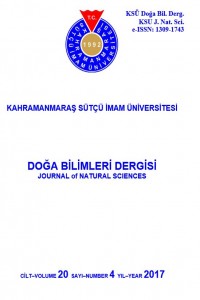Öz
The
aim of this study was to investigate antimicrobial and antioxidant activity of Echinops phaeocephalus extracts prepared with different solvents. For antioxidant potential
evaluation, extraction of E. phaeocephalus was obtained by three
solvents of different polarities including hexane, methanol and chloroform.
Antioxidant potential was evaluated by estimating DPPH radical scavenging
activity, total phenolic activity and total flavonoid activity assay.
Antimicrobial activity was determined by minimal inhibitory concentration (MIC)
and disc diffusion tests. Efficiency of different solvents was compared for the
yield of antioxidant extracts from samples. The study results indicated that, E. phaeocephalus could be an important
natural antioxidant. The evaluations of solvents for effect of extraction resulted
that methanol was more effective than other solvents. Echinops phaeocephalus derived extracts were observed to have varies
effects on microorganisms. The results of the antioxidant activity assay
indicated that the highest phenolic content was in the extract of hexane, while
the highest flavonoid content was in methanol extract. Especially methanol and
hexane extracts showed high efficiency according to DPPH radical scavenging activity results. Our results
concluded that E. phaeocephalus sustains
an important antioxidant and antimicrobial activity.
Anahtar Kelimeler
Compositae phenolic content flavonoid antibacterial antifungal
Kaynakça
- Chang CC, Yang MH, Wen HM, Chern JC 2002. Estimation of Total Flavonoid Content in Propolis by Two Complementary Colorimetric Methods. Journal of Food and Drug Analysis, 10(3): 178-182.
- Dawit A, Ahadu A 1993. Medicinal Plantsand Enigmatic Health Practicesof Northern Ethiopia, Birhanena Selam, Addis Ababa, Ethopia 37–44.
- Gamez-Meza N, Noriega-Rodriguez JA, Medina-Juarez LA, Ortega-Garcia J, Cazarez-Casanova R, Angulo-Guerrero O 1999. Antioxidant activity in soybean oil of extracts from Thompson grape bagasse. Journal of the American Oil Chemists Society, 76: 1445-1447.
- Haslam E 1996. Natural polyphenols (vegetable tannins) as drugs: possible modes of action. Journal of Natural Products, 59: 205-15.
- Hymete A, Iversen TH, Rohloff J, Erko B 2005. Screening of Echinops ellenbeckii and Echinops longisetus for Biological Activities and Chemical Constituents. Phytomedicine 12: 675-679.
- NCCLS (National Committee for Clinical Laboratory Standards) 1999. In Performance standards for antimicrobial susceptibility testing: 9th information supplement. Document M100-S9, Wayne, PA, USA.
- NCCLS (National Committee for Clinical Laboratory Standards) 1997. Performance Standards for Antimicrobial Disk Susceptibility Tests: Approved Standard Enclose -A 7. Wayne, PA,USA.
- Nissen N, Evans S 2012. Exploring the practice and use of Western herbal medicine: Perspectives from the social science literature. Journal of Herbal Medicine, 2: 6-15.
- Singh RP, Pandey VB 1994. Further flavonoids of Echinops niveus. Fitoterapia, 65(4): 374.
- Tadesse, M, Abegaz B 1990. A review of the Genus Echinops (Composite, Craude) in Ethiopia with Notes on Phytogeography and Chemistry. Proceedings of the 12th Plenary Meeting of AETFAT, 4-10 September, Hamburg.
Öz
Bu çalışmada, E. phaeocephalus türünün
antimikrobiyal ve antioksidan aktivitesini araştırmak amaçlanmıştır. E. phaeocephalus türünün
ekstraksiyonları hekzan, methanol ve kloroform olmak üzere üç farklı çözücü
kullanılarak elde edilmiştir. Antioksidan kapasitesi DPPH radikali süpürücü
aktivite tayini, toplam fenolik içeriğin belirlenmesi ve toplam flavanoid
içeriğinin belirlenmesi testleri yapılarak belirlenmiştir. Antimikrobiyal
aktiviteleri disk difüzyon testi ve mikrodilüsyon (MIC) yöntemi kullanılarak
araştırılmıştır. Çözücüler ekstraksiyon
verimi bakımından değerlendirildiğinde metanolün diğer çözücülerden daha etkili
olduğu tespit edilmiştir. Echinops
phaeocephalus türü ekstraktlarının mikroorganizmalar üzerinde değişen
etkilere sahip olduğu gözlenmiştir. Antioksidan aktivite
tayini testleri neticesinde, fenolik madde miktarı en yüksek hekzan ile elde
edilen ekstraktda gözlenirken, flavanoid madde içeriği bakımından zengin olan
ekstrakt metanol ile elde edilen ekstrakt olmuştur. DPPH radikali süpürücü
aktivite tayini sonuçlarında ise özellikle metanol ve hekzan ekstraktlarından
yüksek verim elde edilmiştir. Elde edilen sonuçlar neticesinde de E. phaeocephalus türünün önemli derecede
antioksidan ve antimikrobiyal aktiviteye sahip olduğu belirlenmiştir.
Anahtar Kelimeler
fenolik içerik Compositae flavanoid antibakterial antifungal
Kaynakça
- Chang CC, Yang MH, Wen HM, Chern JC 2002. Estimation of Total Flavonoid Content in Propolis by Two Complementary Colorimetric Methods. Journal of Food and Drug Analysis, 10(3): 178-182.
- Dawit A, Ahadu A 1993. Medicinal Plantsand Enigmatic Health Practicesof Northern Ethiopia, Birhanena Selam, Addis Ababa, Ethopia 37–44.
- Gamez-Meza N, Noriega-Rodriguez JA, Medina-Juarez LA, Ortega-Garcia J, Cazarez-Casanova R, Angulo-Guerrero O 1999. Antioxidant activity in soybean oil of extracts from Thompson grape bagasse. Journal of the American Oil Chemists Society, 76: 1445-1447.
- Haslam E 1996. Natural polyphenols (vegetable tannins) as drugs: possible modes of action. Journal of Natural Products, 59: 205-15.
- Hymete A, Iversen TH, Rohloff J, Erko B 2005. Screening of Echinops ellenbeckii and Echinops longisetus for Biological Activities and Chemical Constituents. Phytomedicine 12: 675-679.
- NCCLS (National Committee for Clinical Laboratory Standards) 1999. In Performance standards for antimicrobial susceptibility testing: 9th information supplement. Document M100-S9, Wayne, PA, USA.
- NCCLS (National Committee for Clinical Laboratory Standards) 1997. Performance Standards for Antimicrobial Disk Susceptibility Tests: Approved Standard Enclose -A 7. Wayne, PA,USA.
- Nissen N, Evans S 2012. Exploring the practice and use of Western herbal medicine: Perspectives from the social science literature. Journal of Herbal Medicine, 2: 6-15.
- Singh RP, Pandey VB 1994. Further flavonoids of Echinops niveus. Fitoterapia, 65(4): 374.
- Tadesse, M, Abegaz B 1990. A review of the Genus Echinops (Composite, Craude) in Ethiopia with Notes on Phytogeography and Chemistry. Proceedings of the 12th Plenary Meeting of AETFAT, 4-10 September, Hamburg.
Ayrıntılar
| Bölüm | Araştırma Makalesi |
|---|---|
| Yazarlar | |
| Yayımlanma Tarihi | 1 Ağustos 2017 |
| Kabul Tarihi | 21 Şubat 2017 |
| Yayımlandığı Sayı | Yıl 2017 Cilt: 20 Sayı: 4 |

